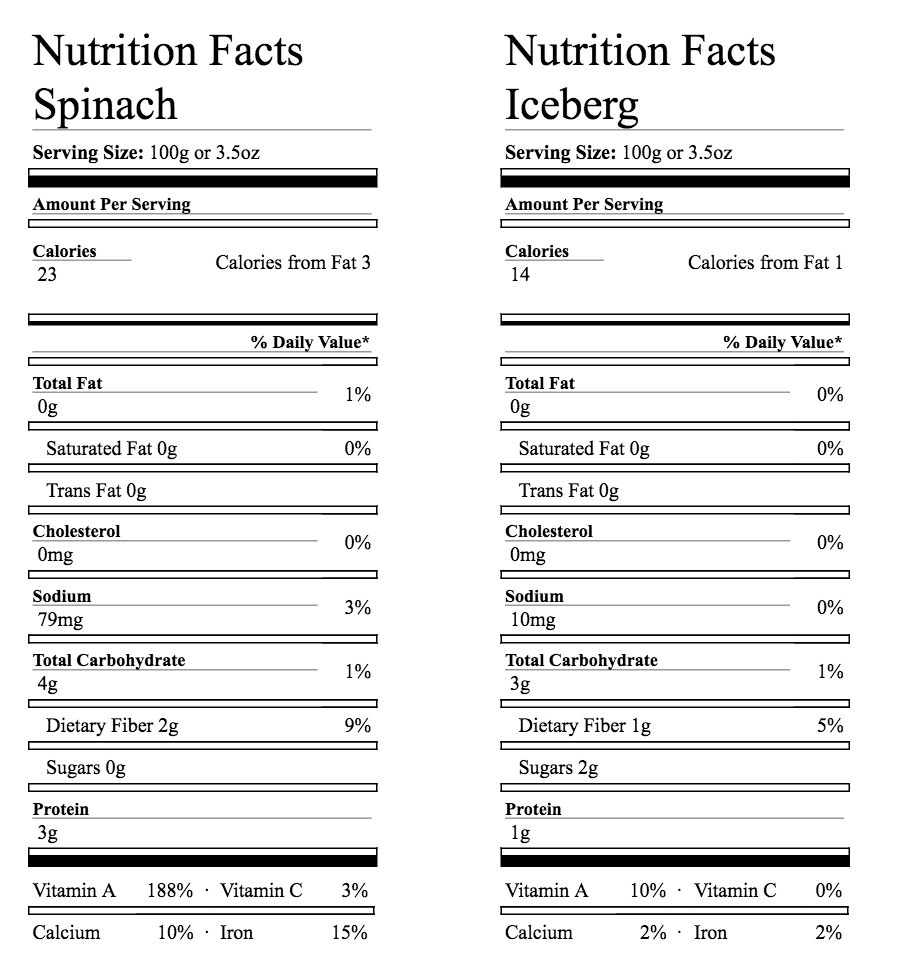Spinach is one of my favorite ways to enjoy more plant-based compounds called carotenoids. Spinach contains the important carotenoids lutein and zeaxanthin, which are the only antioxidants found in the eye. What I love about lutein is its ability to protect our eyes from blue light (the light from your smartphone and screen time) as well as decreasing our risk of age-related cataracts and macular degeneration. Spinach has significantly more of lutein and zeaxanthin than iceberg lettuce. I want you to swap your iceberg lettuce for the more nutrient-dense spinach. Seeing is believing though so take a look at the incredible differences between spinach and iceberg. You won’t believe it! And my hope is that you won’t touch iceberg ever again.
Here’s a nutritional breakdown showing how clear it is that spinach is the preferred choice over iceberg:



Vitamin A
There are some impressive differences between the nutrient levels in spinach as compared to iceberg lettuce! Not only does spinach contain more lutein and zeaxanthin, but almost 20 times more vitamin A than iceberg lettuce. Vitamin A is a vital nutrient for maintaining good vision, enhancing immune function and having beautiful skin.
Folate
A Harvard study revealed that women had a reduced risk of age-related macular degeneration when including the synthetic form of folate (folic acid) as part of their daily supplementation. You can get almost 6 times more of the natural form of folate in spinach than iceberg lettuce. Folate plays an important role in DNA synthesis and repair, helping to keep your cells healthy and youthful.
Fiber
Spinach has twice as much fiber as iceberg lettuce. While that may not seem like all that much, every bit counts towards the recommended daily 25 grams of fiber for women under the age of 50. Fiber keeps the microbiome and immune system working optimally and promotes hormonal health.
Minerals
Lastly, spinach contains an abundance of minerals…precious minerals like iron, magnesium, and calcium— responsible for keeping our cells oxygenated, our bones healthy, and heart strong.
I hope I’ve convinced you to say “good-bye iceberg lettuce, hello spinach!” If you still need a little more enticing, perhaps this BEST Salad recipe will give you that extra inspiration!
BEST Salad
(Bacon, Endive, Spinach and Tomato Salad)
Serves: 4
Prep time: 10 minutes
Cook Time: 15 minutes
Ingredients:
1 pound nitrite-free bacon
7 ounces endive
13 cups or roughly 1 1/4 pound fresh, organic spinach
1 cup organic cherry tomatoes, sliced in half (if preferred)
1 cup virgin olive oil
Juice from 1 lemon
½ teaspoon sea salt
½ teaspoon black pepper
Instructions:
Place bacon slices in an unheated skillet and cook on low heat until it reaches your preferred level of doneness.* Alternatively, preheat your oven to 400F and line a large baking sheet with aluminum foil. Arrange the bacon strips on the foil and place baking sheet on the middle oven rack. Cook bacon for 10-15 minutes. Transfer to a plate lined with paper towel to absorb the extra grease. Set aside to cool and chop into small pieces.
Coarsely chop endive. Place in a large salad bowl and add spinach.
Whisk the olive oil, lemon juice, sea salt and black pepper together. Add to spinach and endive and toss to coat. Mix in tomatoes and bacon until well distributed.
*Note—Overcooking bacon until it is crispy and black creates carcinogenic and inflammatory compounds that your body has to detoxify.
Nutrition Facts: (serving size: 1 serving) Fat: 24 g Protein: 7 g Fiber: 4 g Carb: 8 g Net Carb: 4 g





